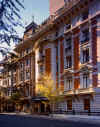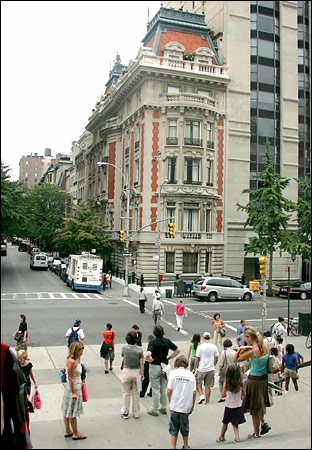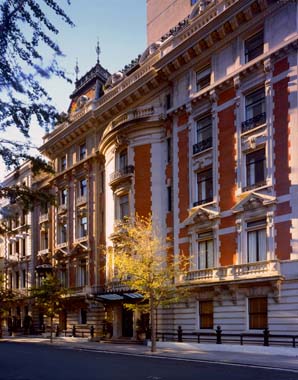 |
New York
Architecture Images-Upper East Side
Duke House
|
|
architect |
designed by Alexander Welch of Welch, Smith & Provot. |
|
location |
1009
Fifth Ave At 82nd St. |
|
date |
1901 |
|
style |
French classical Neoclassical |
|
construction |
Built on speculation by W. W. &
T. Hall. This red-brick building has large curved bays on its avenue and sidestreet frontages topped by balustrated balconies, a very handsome rusticated limestone one-story base, limestone quoins, a handsome fenced moat, and a delightful mansard roof capped with finials that were replaced in 1985 when the building was renovated and subdivided into apartments. |
|
type |
House |
|
|
  |
|
A $50 Million Price Tag, and Still a
Fixer-Upper?
By MOTOKO RICH Published: August 10, 2005 With the average price of an apartment in Manhattan now comfortably nested over $1 million, many New Yorkers are pretty blasé about all those zeros. Semans Family Limited Partnership A sweeping brass-and-wrought-iron staircase inside the Duke Semans Mansion, top. A small kitchen in the former butler's pantry. Vincent Laforet/The New York Times The Duke Semans Mansion has 20,000 square feet of space. But $50 million got people talking when relatives of Doris Duke, the late tobacco heiress, put the Duke Semans Mansion, a 20,000-square-foot Beaux-Arts residence, on the market in May. The 1901 townhouse is said to be the last great private mansion on Fifth Avenue - and at that price would be the most expensive private residence ever sold in the city. Lenny Kravitz, the rock star and budding designer, has visited the house twice, said Mamdouh Nasr, the owner of an ice cream truck that has parked for 28 years on the corner of 82nd Street and Fifth Avenue, just steps from the mansion's front door. To Mr. Nasr, it's clear evidence that the musician, who enjoys buying and fixing up real estate, is buying the home. "To this guy time is money," Mr. Nasr said. "So why he comes inside two times?" The Semans family, Duke descendents who own the property, are negotiating with Mr. Kravitz on the sale, according to a person informed of the deal who asked not to be identified because there is no signed deal. While Mr. Kravitz might hear music in ice cream truck bells, anyone who buys the house will find what has been described in marketing materials as the "most important example of Beaux-Arts residential architecture in the city." The red brick and limestone building has a mansard roof and a view of the Metropolitan Museum of Art. As a reporter noted this week on a tour of five of its eight floors, it has grand, well-lighted rooms, 11 marble fireplaces, three elevators and a sweeping brass-and-wrought-iron staircase. A prospective buyer might also note wood paneling buckling in the receiving room, a small kitchen in the former butler's pantry and a tiny toilet in an otherwise striking marble bathroom. Fourteen interested parties have visited the property and three have bid on it, according to Sharon Baum, a senior vice president with the Corcoran Group, who is sharing the listing with Paula Del Nunzio and Shirley Mueller of Brown Harris Stevens. All three brokers and members of the Semans family declined to identify a prospective buyer, and all said no deal had been made final. Mr. Kravitz, who is trying to sell a loft in SoHo for $12.95 million and also owns property in New Orleans, has recently formed his own design company. A spokeswoman for Mr. Kravitz declined to comment. If he buys the Duke mansion, it will be a great design challenge. Built by the developers William and Thomas Hall, it has always been owned by members of the Duke family. According to Iver Iverson, a historic preservationist who helped the family reconfigure the mansion's three apartments in the 1990's and overhauled the house's plumbing and heating systems, the building last underwent a major exterior renovation in the 1980's, when the copper and iron balustrades were replaced. Starting in 1918, he said, many of the property's striking interior features were installed by Mary Duke Biddle, daughter of Benjamin Newton Duke, co-founder of the American Tobacco Company and the original buyer of the house. She brought in brass and wrought-iron railings on the staircases, removed plaster work from some of the cornices, put all-black marble fixtures in one of the bathrooms and hung Directoire-style paintings from France in the dining room. Real estate brokers who have seen the property say a buyer would likely have to invest $10 million to renovate it. Because the property is now divided into three apartments - one on the first five floors, a small one-bedroom apartment on the fifth floor and a penthouse on the sixth and seventh floors - and includes a doctor's office in the basement, anyone who wants to turn it back into a single-family residence will have to do substantial work. Still, there is no question that the location - in an area once known as Millionaires Row - and bones of the house are magnificent. On a Fifth Avenue block where all the other single-family residences have long since been torn down and replaced by apartment buildings, the Duke Semans Mansion, for which the family fought to get landmark designation, stands as a bulwark against modern development. With its high ceilings, gold-leaf trimmed fixtures and intricate plaster friezes, the property is a living piece of architectural history. Mary Duke Biddle Trent Semans, the 85-year-old granddaughter of Benjamin Duke, said in a telephone interview from Durham, N.C., that she hoped the ultimate buyer would preserve the house, which was granted landmark status in 1974, as close as possible to its current state. "The only thing I would like is that they keep the house sort of the way it is now," said Mrs. Semans, who lived in the house until she was 14 and recalls peering out at the stone goddesses on a cornice of the Met from her bedroom window on the fourth floor. Ms. Baum, a broker who regularly sells multimillion-dollar residences, said most buyers who have come to see the Duke-Semans property understood its architectural significance. "We did not have anybody say, 'this is great, I think I will just gut it and turn it into the hugest loft that anybody has ever seen,' " she said. Marketing the property has been an unusual challenge for Ms. Baum, Ms. Del Nunzio and Ms. Mueller, who was chosen to represent the listing by the Semans family in part because she once rented an apartment in the house. The seller is offering a 4 percent commission instead of the more typical 6 percent. That could be up to $2 million on a $50 million sale. That price would beat $24.5 million paid for Woody Allen's Carnegie Hill townhouse last year, as well as $44 million paid by Rupert Murdoch for a co-op on Fifth Avenue at 64th Street. Before showing the property, the brokers check any prospective buyer for financial qualifications. "When you work with these trophy properties you just get a lot of people who are sightseers," Ms. Baum said earlier this week as she climbed the curving staircase. "They just want to see a great house." Buyers who are boldface names or come represented by a reputable broker can get a showing pretty quickly. Sometimes, Ms. Baum said, she has had to search Google or Lexis/Nexus to learn more. Arranging showings on the property, which has been on and off the market since May, has been difficult, Ms. Baum said, because visits have to be cleared with the two rental tenants in the building. If staff members are on vacation, Ms. Baum said, the brokers cannot get in. On initial showings, Ms. Baum said, buyers are allowed to see only the first five floors of the property. Only the three buyers who have made offers have been allowed to see the penthouse floors, and even then, the brokers are not allowed to accompany the buyers. Despite such obstacles, Mrs. Semans said she was hopeful that a deal would be signed soon. Saying goodbye to a property that has been in the family for more than 100 years, though, she said would not be easy. "We're very blue about it," she said, noting that not one of her 7 children, 14 grandchildren and 18 great-grandchildren live anywhere near New York City. "But the main thing is to do something that someone else is going to enjoy." NYT |
|
|
links |
|